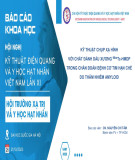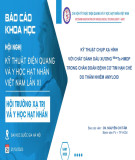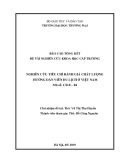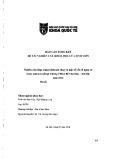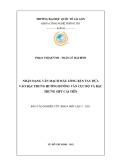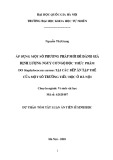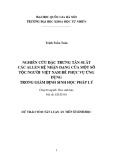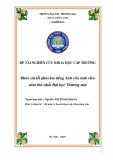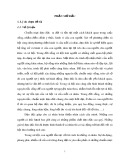
RESEARC H Open Access
Responsiveness of the Eating Disorders Quality of
Life Scale (EDQLS) in a longitudinal multi-site
sample
Carol E Adair
1*
, Gisele C Marcoux
1,2
, Theanna F Bischoff
3
, Brian S Cram
1,2
, Carol J Ewashen
4
, Jorge Pinzon
2
,
Joanne L Gusella
6
, Josie Geller
5,7
, Yvette Scattolon
8
, Patricia Fergusson
9
, Lisa Styles
10
, Krista E Brown
11
Abstract
Background: In eating disorders (EDs), treatment outcome measurement has traditionally focused on symptom
reduction rather than functioning or quality of life (QoL). The Eating Disorders Quality of Life Scale (EDQLS) was
recently developed to allow for measurement of broader outcomes. We examined responsiveness of the EDQLS in
a longitudinal multi-site study.
Methods: The EDQLS and comparator generic QoL scales were collected in person at baseline, and 3 and 6
months from 130 participants (mean age 25.6 years; range 14-60) in 12 treatment programs in four Canadian
provinces. Total score differences across the time points and responsiveness were examined using both anchor-
and distribution-based methods.
Results: 98 (75%) and 85 (65%) responses were received at 3 and 6 months respectively. No statistically significant
differences were found between the baseline sample and those lost to follow-up on any measured characteristic.
Mean EDQLS total scores increased from 110 (SD = 24) to 124.5 (SD = 29) at 3 months and 129 (SD = 28) at 6
months, and the difference by time was tested using a general linear model (GLM) to account for repeated
measurement (p < .001). Responsiveness was good overall (Cohen’s d = .61 and .80), and confirmed using anchor
methods across 5 levels of self-reported improvement in health status (p < .001). Effect sizes across time were
moderate or large for for all age groups. Internal consistency (Chronbach’s alpha=.96) held across measurement
points and patterns of responsiveness held across subscales. EDQLS responsiveness exceeded that of the Quality of
Life Inventory, the Short Form-12 (mental and physical subscales) and was similar to the 16-dimension quality of
life scale.
Conclusions: The EDQLS is responsive to change in geographically diverse and clinically heterogeneous programs
over a relatively short time period in adolescents and adults. It shows promise as an outcome measure for both
research and clinical practice.
Background
Eating disorders (EDs) are serious health problems that
adversely impact quality of life in adolescence and
young adulthood; a critical time for individuation and
establishing independence across several life domains
including initiation of careers [1-3]. Unhealthy eating
attitudes and dieting behaviors that elevate risk for EDs
are found in nearly 30% of girls aged 10 to18 years and
increases in concern with weight over time have been
documented for both boys and girls aged 9 to 14 [4-6].
These trends imply that EDs will continue to be a sig-
nificant health concern for the foreseeable future.
If not treated early and effectively, EDs can become
chronic, and place enormous burden on the patient and
his or her family [7]. Demand for treatment services is
growing, along with an urgency to ground new treat-
ments in evidence [8,9]. Treatment outcome measure-
ment in EDs has traditionally focused on changing
* Correspondence: ceadair@ucalgary.ca
1
Departments of Community Health Sciences and Psychiatry, Faculty of
Medicine, University of Calgary, 1215 - 39 Ave, SW, Calgary, AB, T2T 2K6,
Canada
Full list of author information is available at the end of the article
Adair et al.Health and Quality of Life Outcomes 2010, 8:83
http://www.hqlo.com/content/8/1/83
© 2010 Adair et al; licensee BioMed Central Ltd. This is an Open Access article distributed under the terms of the Creative Commons
Attribution License (http://creativecommons.org/licenses/by/2.0), which permits unrestricted use, distribution, and reproduction in
any medium, provided the original work is properly cited.

behavior and symptoms (e.g., reducing purging or
restoring a healthy body weight) rather than on broader
areas such as role functioning or quality of life, and ED
experts have been calling for more holistic approaches
to treatment and for broader treatment outcome mea-
surement for more than a decade [10-12]. For example,
Miller [11] characterized the traditional approach to
EDs treatment outcomes measurement as “too simplistic
and narrow in scope,”(p. 745) and Treasure [13] wrote
that “to focus merely on symptomatic relief from ‘not
eating’, as occurs with some forms of hospital care, is
primitive,”(p. 212). In this paper, we describe a study to
establish responsiveness in a new disease-specific quality
of life (QoL) measure for EDs that taps these broader
outcomes.
While broader outcomes have been measured in some
research samples of ED patients using generic quality of
life (QoL) instruments, including the Short-Form-36
(SF-36), the Nottingham Health Profile (NHP) and the
World Health Organization Quality of Life Instrument -
Brief Version (WHO QoL-Bref) [2], they have several
limitations. Some domains and items on generic QoL
instruments may be insensitive for some diagnoses [14],
and responsiveness may be inadequate for evaluative
purposes [15-17]. In addition, wording and interpreta-
tion problems with the SF-36 have been found for some
patient groups including EDs [14,18,19]. QoL measure-
ment in practice has been limited by a lack of availabil-
ity of specific QoL measures for the EDs field, and as a
result, many calls for a specific, relevant and responsive
QoL measure have been made in the past decade
[2,20-24]. In response to these identified issues, four
new disease-specific instruments for EDs, including the
subject of the current paper - the Eating Disorders
Quality of Life Scale (EDQLS), were reported in the past
three years [20,21,23,24]. An article describing an instru-
ment to measure impairment resulting from ED psycho-
pathology has also been recently published, but, as
described, neither the important conceptual distinctions
between impairment and quality of life; nor the com-
plexity of causal pathways between symptoms and beha-
vioural manifestation in the illness, are recognized [25].
Two of these instruments were tested in an age range
that included adolescents, but adolescent-specific design
methods (e.g., testing relevance of content and appropri-
ateness of language) are reported only for the EDQLS
[24].
The EDQLS was designed for an evaluative purpose,
(i.e., to measure change over time within individuals)
[17], such as for the assessment of patients’treatment
progress and the outcomes of new treatments [11].
Given this, responsiveness is the psychometric charac-
teristic of primary importance. According to Revicki
[26], responsiveness refers to “the extent to which a
measure accurately reflects change in a patient’scondi-
tion,”(p. 890).
Only one of the recently developed disease-specific
QoL instruments for EDs has published findings on
responsiveness [27]. The authors used distribution and
anchor-based methods to examine responsiveness and
found effect sizes around .30 (varying by subscale) for
patients from three treatment programs in one city who
reported improvement at one point of follow-up (12
months). These results are encouraging in suggesting
that measured QoL can improve over time with treat-
ment for EDs. However, this instrument (by Las Hayas
and colleagues) emphasizes symptomatic aspects of the
illness, which might be more likely to change with treat-
ment than broader life domains [27]. It is also critical to
ensure that instruments such as the EDQLS, that tap
broader life domains such as leisure and relationships,
are also responsive to treatment, especially when used
to evaluate treatments targeted to broader outcomes. In
addition, Las Hayas and colleagues did not report the
use of design processes to ensure appropriateness to
adolescents, so responsiveness in an instrument such as
the EDQLS with this feature was warranted. The pur-
pose of the current study was to examine responsiveness
in an instrument designed to be appropriate across the
full range of patient ages and which taps broad domains
of QoL, across three time points for patients, including
adolescents, in active treatment across multiple geogra-
phically diverse treatment programs.
Methods
The Longitudinal Sample
165 females and six males aged 14 years or older with
a clinically confirmed diagnosis (anorexia nervosa, buli-
mia nervosa or eating disorders not otherwise speci-
fied) participated in the multi-site study. They came
from 12 Canadian EDs treatment programs (two in
Nova Scotia, three in Manitoba, five in British Colum-
bia, and two in Alberta) providing any of inpatient,
outpatient, day treatment and/or consultation to ado-
lescent or adult patients. Approaches to treatment in
these programs varied widely from inpatient medical
weight restoration through individual, group or family
psychotherapy based on several current therapeutic
models, and supplementary therapies such as meal pre-
paration/nutrition skill-building and recreational
approaches. The intensity of current treatments and
the structure of the treatment team also varied consid-
erably. Patients were included if they had been in
treatment at least two weeks and at the time of base-
line measurement were at variable stages of treatment.
Participants were recruited through presentations by
the research assistant in group therapy sessions, and
by individual clinician referrals.
Adair et al.Health and Quality of Life Outcomes 2010, 8:83
http://www.hqlo.com/content/8/1/83
Page 2 of 11

The Eating Disorders Quality of Life Scale
The EDQLS is based on the World Health Organiza-
tion’s definition of QoL [28] and its development was
guided by published standards [26,29-33]. Content was
selected to capture broad aspects of life affected by EDs
and their treatment (i.e., health-related QoL), but over-
lap in content with instruments that measure ED symp-
toms and behaviors alone was avoided. Example items
from the final 40-item EDQLS are “Ihavealotofrules
about food”(health related to food and weight domain
(also called the eating domain) and “I feel connected to
others”(relationships with others domain). The 12
domains or subscales are cognitive, education/vocation,
family and close relationships, relationships with others,
future outlook, appearance, leisure, psychological, emo-
tional, values and beliefs, physical, and eating. Each
domain has three items, except for the health related to
food and weight/eating domain, which has six items
plus an extra item that is similarly worded with one in
the cognitive domain that was designed to be used as an
internal validity check. The minimum and maximum
scores are 40 and 200 respectively. The EDQLS was
developed and validated for ages as young as 14, and is
currently being tested in youth ages nine to 13 years.
Recent work using cognitive interviewing [34-36]
resulted in refinements to six items. The results
reported herein relate to the first version.
A single global QoL rating: “Please rate your overall
quality of life in the last week on a scale of 1 to 10,
where 1 is Poor and 10 is Excellent“is included in a
separate part of the questionnaire booklet to allow for
overall construct validity assessment as recommended
by Fayers and Fayers (2000) [31]. In an additional sepa-
rate section of the questionnaire booklet, the 12 QoL
domains are listed, and respondents are able to rate the
importance of each (on a five-point scale), as well as up
to two additional self-nominated domains. The impor-
tance ratings are not used to weight the total domain
scores derived from the core 40 items, as per current
recommendations [37], but they provide an opportunity
for the patient and clinician to consider and address
uniqueQoLissuesandgoalsasanadjuncttothestan-
dard scores.
The total mean score on the initial validation sample
(pilot and longitudinal sample at baseline - N = 171)
was 110 out of a total of 200 (SD = 24.1) with higher
scores indicating better QoL. Since patients were at
varying stages of treatment, the baseline scores simply
represent the first score for each participant. The
EDQLS showed excellent internal consistency overall
(Cronbach’s alpha = .96) and for most subscales. Criter-
ion validity (both convergent and divergent) was estab-
lished in that sample using comparisons with the
Quality of Life Inventory (Qoli) [38], Short-Form-12
(SF-12) [39], and a generic sixteen-dimensional health-
related measure for youth (the 16D) [40]. Known groups
validity was also demonstrated on the baseline sample,
and construct validity was examined using principal
components analysis and exploratory item response the-
ory analysis. Full details on the development and initial
validation of the EDQLS are available elsewhere [24].
Validation measures and other variables
The three comparator instruments noted above - the
SF-12, the QoLI and the 16D - were used to assess
responsiveness across instruments for the longitudinal
sample. The SF-12 is a brief version of the SF-36, an
extensively tested and validated health status instrument
used in many patient populations to measure health-
related functioning and frequently used as an indicator
of QoL [39]. Its 12 items address activities such as play-
ing golf and climbing stairs, as well as limitations in per-
forming physical tasks, and in working or socializing due
to physical and emotional problems or pain. This mea-
sure also provides summary scores for both mental and
physical health status [39]. The QoLI is a generic QoL
lifeinstrument[38].Ithas32itemsthataddress16
areas of life (health, self-esteem, goals and values,
money, work, play, learning, creativity, helping, love,
friends, children, relatives, home, neighborhood and
community), and both importance and satisfaction rat-
ings for each. It has been validated in several clinical
and non-clinical populations and has good internal con-
sistency (values ranging from .77 to .89) [38]. The 16D
is also a generic QoL measure. However, it is designed
specifically for youth aged 12 to 15 [40]. It covers 16
dimensions (mobility, vision, hearing, breathing, sleep-
ing, eating, elimination, speech, mental function, dis-
comfort and symptoms, school and hobbies, friends,
physical appearance, depression, distress and vitality)
with a single item for each dimension. It has good test-
retest reliability and known group validity [40]. The 16D
was selected for the current study to assess the appro-
priateness of the EDQLS in a sample that included a
large proportion of adolescents (approximately one-third
were under age 18 and approximately three-quarters
were under age 29 at baseline). Two other standardized
instruments were administered at baseline to measure
general psychiatric symptom severity and ED symptom
severity - the Brief Symptom Inventory (BSI) [41] and
the Eating Disorders Inventory 2 (EDI-2) [42]. The BSI
assesses psychiatric symptoms with 53 items in nine
domains including somatization, obsession-compulsion,
interpersonal sensitivity, depression, anxiety, hostility,
phobic anxiety, paranoid ideation and psychoticism, and
provides an overall score indicative of intensity of symp-
toms. The EDI-2 has 64 items in eight subscales reflect-
ing eating disorders psychopathology/symptomology:
Adair et al.Health and Quality of Life Outcomes 2010, 8:83
http://www.hqlo.com/content/8/1/83
Page 3 of 11

drive for thinness, bulimia, body dissatisfaction, ineffec-
tiveness, perfectionism, interpersonal distrust, interocep-
tive awareness, and maturity fears. Subscale scores and a
total score are available. In this study, raw scores were
used as a simple continuous variable indicator of ED
symptom severity, because cut-offs for clinical signifi-
cance were not provided, and individual clinical compar-
isons were not needed.
Other variables of interest including age, gender, diag-
nosis, psychiatric and medical comorbidity, prior treat-
ment, age at first symptoms, eating disorder duration,
and current program treatment duration were collected
from the health record at baseline using a standard, pre-
tested abstraction form. At three and six month data
collection points, respondents were also asked to rate
their overall health status on a five-point scale: ‘much
worse’,‘worse’,‘same’,‘better’or ‘much better’.They
also provided supplementary information on whether
they had completed or withdrawn from treatment,
attributed their current status to their treatment, and
whether anything other than treatment had happened
that impacted their current status. The original instru-
ment battery underwent review by clinical collaborators
at the sites, as well as pre-testing with eight adolescents/
young adults (aged 13 to 31) to assess burden, compre-
hension, and completion time.
Data collection and management
All data were collected in person at baseline with assis-
tance as needed, and by mail three and six months later.
The follow-up protocol, based on the Dillman total
design method for mailed surveys [43], included remin-
der letters at one week from the initial mailing, and a
full study package re-mailed at three weeks, followed by
phone calls to non-respondents. A final written appeal
was sent to non-respondents approximately 8 to 10
weeks later. Study data were entered to an SPSS data-
base. Error rates were measured on a 10% random sam-
ple, and confirmed to be less than 1% (mean .58%
across time points). Missing data were minimal, and
handled using standard decision-rules (e.g., inserting
subscale means) and dual-rater agreement on items
requiring judgment (such as response corrections).
Analysis
There is currently no agreement on the optimal
approach to responsiveness analysis [15,44-48]. There-
fore, we calculated several indices of responsiveness and
used both distribution- and anchor-based approaches.
First, line and boxplots of EDQLS individual, mean total
scores and subscale scores were inspected across time
points. Sample differences were tested using Student’st-
tests for mean differences, Pearson’s chi-squared tests
and (for diagnosis due to small cell frequencies) Fisher’s
exact test. Responsiveness was examined first using dis-
tribution-based approaches and calculated as Cohen’sd,
total score change, percent change and the standardized
reponse mean across time periods. Next, mean score
differences by time period were tested for statistical sig-
nificance using a general linear model (GLM) that
accounts for repeated measurement for participants with
data across all time points; no other variables were
included in this model because of the relatively small
sample size. Responsiveness was also examined using an
anchor-based approach, in which the magnitude change
in total scores from baseline to the three-month time
point was examined across five levels of self-reported
change using a one-way ANOVA. Finally, effect sizes
and standardized response means (based on absolute
score changes) were calculated across time points for
the EDQLS total score, for subscale scores, by age
group, and for scores on the three comparator instru-
ments.Allanalyseswerebasedontheentiresample
(versus comparision to a treatment as usual or untreated
sample) because all participants were in active treatment
at enrolment. The study was reviewed and approved by
the Conjoint Health Research Ethics Board at the Uni-
versity of Calgary, and the respective committees for
each jurisdiction.
Results
Sample Description
The initial 41 participants were a pilot sample for which
consent had not been collected for follow-up; thus, 130
participants formed the longitudinal sample. 98 (75%)
and 85 (65%) responses were received at three and six
months respectively. Table 1 details patient characteris-
tics for the baseline, three and six month samples, and
the 45 participants lost to follow-up at six months. No
differences were found on age, gender, diagnosis, eating
disorders or psychiatric symptom severity, comorbidity,
age at first symptoms, illness duration, previous treat-
ment or time in treatment between the initial sample
and those lost to follow-up at 6 months, although there
may have been insufficient power for the detection of
differences of the magnitude seen here, especially for
variables with many categories. For example, the sample
of those lost at six months seemed to include more par-
ticipants with a diagnosis of bulimia and more of those
who had had previous treatment. BSI and EDI-2 severity
scores also appeared to be higher among those lost, yet
smaller proportions had documented psychiatric and
medical comorbidities.
The sample included participants at a full range of
stages of treatment. At baseline, 14 (17%) had been in
treatment for two months or less, 28 (34.1%) for two to
Adair et al.Health and Quality of Life Outcomes 2010, 8:83
http://www.hqlo.com/content/8/1/83
Page 4 of 11

six months; six (7.3%) for six to 12 months; 12 (14.6%)
for seven to 12 months; 10 (12.2%) for 13 to 24 months
and 12 (14.6%) for longer than 24 months (one missing).
Treatment status at the six-month point was reported
by 76 respondents. Among those, 30 (39%) reported still
being active in the same program, six (8%) active in
another program, 16 (21%) had been discharged from
the original program and were being followed by a
family physician/GP,15 (19.7%) reported having com-
pleted all treatment, and nine (12%) withdrew. The
majority of those who withdrew left for lifestyle reasons
(e.g., moved or got a full-time job); only three (4%)
reported that they were not benefiting from services or
were otherwise unhappy with services. Overall, 67 (88%)
responded positively when asked whether treatment for
the ED had made their health better.
Responsiveness According to Distribution-Based
Approaches
Total mean scores on the EDQLS increased from 110
(SD=24)to124.5(SD=29)atthreemonthsand129
(SD = 28) at six months. These score differences were sta-
tistically significant (p < .001) using GLM to account for
repeated measurement (Figure 1). Even though, on aver-
age, QoL scores increased, the patterns of change were
highly individual. The largest increase was seen from base-
line to three months, with a smaller gain from three to six
months. Internal consistency of the total score was the
same at all time points (Chronbach’s alpha = .96). Correla-
tions between two items in the scale tapping an identical
concept but worded slightly differently and designed to
indicate internal validity were also strong across time
points (Pearson’s r = .78, .81, and .75 respectively).
Table 1 Sample characteristics: Baseline, 6 months, and for those Lost to Follow-up at 6 months
Patient Characteristic
(as measured at Baseline)
All
Participants
(N = 130)
Those seen at
6 Months
(N = 85)
Those lost to
follow-up at
6 months
(N = 45)
Mean Age
(SD)
25.6
(10.5)
25.4
(10.3)
26.0
(11.2)
~
Gender
(n; % female)
124
(95.4)
81
(95.3)
43
(95.6)
#
Diagnosis
(n; %)
Anorexia Nervosa - Restricting 36
(27.7)
25
(29.4)
11
(24.4)^
Anorexia Nervosa - Binge/Purge 20
(15.4)
17
(20.0)
3
(6.7)
Bulimia Nervosa 39
(30.0)
19
(22.4)
20
(44.4)
EDNOS 35
(26.9)
24
(28.2)
11
(24.4)
BSI
1
Global Severity Score 1.56
(.78)
1.49
(.77)
1.71
(.78)
~
EDI II
2
Total Score 100.5
(45.2)
97.8
(42.8)
105.6
(49.4)
~
Psychiatric Comorbidity
(n; %)
88
(67.7)
63
(74.1)
25
(55.6)
#
Medical Comorbidity
(n; %)
45
(34.6)
32
(37.6)
13
(28.9)
#
Age Symptoms First Appeared
(years; SD)
15.3
(4.7)
15.3
(4.8)
15.3
(4.5)
~
Previous Treatment
(n;%)
86
(66.2)
54
(63.5)
32
(71.1)
#
Mean Time in Treatment
(months; SD)
12.5
(15.8)
12.9
(16.5)
11.7
(14.5)
~
Eating Disorder Duration
(years)
9.7
(9.1)
9.7
(8.8)
9.8
(9.7)
~
1
Brief Symptom Inventory
2
Eating Disorder Inventory II Total Score (all subscales, clinical scoring)
~ Difference between All participants and those Lost at 6 months not significant using Student’s t-tests at alpha level p = .05
# Difference between All participants and those Lost at 6 months not significant using Pearson’s chi-squared test at alpha level p = .05
^ Difference between All participants and those Lost at 6 months not significant using Fisher’s Exact test at alpha level p=.05
Adair et al.Health and Quality of Life Outcomes 2010, 8:83
http://www.hqlo.com/content/8/1/83
Page 5 of 11


